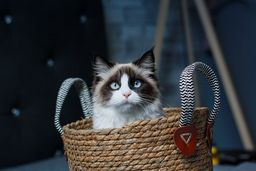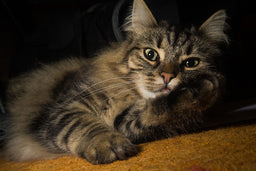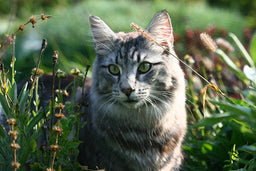Norwegian Forest cat grooming—a complete guide
A Norwegian Forest cat is a perfect embodiment of the Viking spirit. There is something ruggedly handsome about them, and they seem like mighty Nordic warriors of the feline world. Some believe that Norwegian Forest cats had an essential role on the Viking longboats, handling various pests.
Their marauding days are long gone, and these majestic creatures now have a chance to display their sweet and gentle side. As for their looks—they expect some pampering to help them stay dashing!
Untamed presents all you need to know about Norwegian Forest cat grooming and offers practical tips to keep your feline companion happy, healthy, and pretty.
Understanding the Norwegian Forest cat fur
Norwegian Forest cats are not a human creation. They are a natural breed, which means these kitties evolved naturally to what they are today.
Norwegian Forests have exceptionally dense fur designed to protect them from the harsh northern weather. Their double coat consists of:
- Guard hairs—A water-resistant layer of fur
- Downy—A warm undercoat
These felines have heavily furnished ears, set low on the head to prevent heat loss. Their paws are also fully tufted to protect their feet from the cold ground. With so much hair everywhere, anyone adopting a Norwegian Forest cat has to wonder— how much grooming do these kitties need to keep their long hair from getting tangled beyond help?
Grooming a Norwegian Forest cat

Just five more minutes or playtime, and then you can brush me.
Source: Miron Cristina
Norwegian Forest cats are surprisingly low maintenance.
Grooming your Wegie entails:
- Brushing
- Bathing
- Teeth cleaning
- Nail trimming
Brushing your Norwegian Forest cat
Despite their long fur, there is no need to spend a lot of time brushing Wegies because their coats don't mat and tangle much.
In nature, these felines rub against trees to remove loose hair during the shedding seasons. Domesticated kitties are not much different. They may not look for a tree trunk to rub against to remove the dead hair, but they will spend a lot of time looking after their coats. That makes your job significantly easier.
A good brush once a week is more than enough to keep your kitty's fur detangled and fabulous-looking. The best brush for a Norwegian Forest cat is a wire bristle brush or a metal comb.
Bathing your Wegie
You don't have to bathe your Norwegian Forest cat often unless they get dirty (which they might if you let them play outside).
A professional groomer might be a wise choice because Wegies' coats are water-resistant, and getting them thoroughly soaked may be challenging. The good news is that, like their Siberian and Bengal cousins, these felines are known to enjoy water, so baths should be fun for them.
Cleaning your Norwegian Forest cat's teeth
You must clean your Norwegian Forest’s teeth as often as possible. Good oral hygiene will keep their teeth healthy, contributing significantly to your kitty's overall health.
If you neglect this step, the plaque build-up on your feline's teeth can cause gum inflammation, which is usually painful, so your cat may stop eating, especially if you feed them dry food. Inflammation can lead to infection, which affects their teeth and potentially spreads to the bloodstream and the rest of the body. In that case, tooth resorption will be the least of the problems.
To prevent unnecessary complications, brush your Norwegian Forest cat's teeth daily. It's best to start with this ritual when they are young, so they get used to the sensation. Get a special brush designed for felines and toothpaste for cats and dogs because human toothpaste can make your feline friend sick.

No way! I’m not opening my mouth!
Source: Anete Lusina
In case your Wedgie cannot get used to the toothbrush, try the following:
- Introduce them to the toothbrush gradually—Put some wet food on the brush and let your furry friend lick it. Do it for several days, then try to put the brush into your kitty's mouth. Monitor their reaction and never use force
- Start with gauze on your finger—Your kitty may respond better to your finger at first, and it can help get them used to the process
Once your Wegie allows you to brush their teeth with a toothbrush, be gentle. Never put much pressure on their gums and teeth because it can hurt them.
Trimming your Wegie's nails
Your Norwegian Forest cat must have a sturdy and large enough scratching post where they can file their nails. For most kitties, a scratching post is enough to keep their nails in check, but if your Wegie doesn't use their claws much, you may need to trim them occasionally.
You should use kitty nail clippers and only cut the white tip of the claw. Unless your kitty's nails are pigmented, it will be easy to avoid the pink part of the nail. If their claws are dark, take your companion to a groomer to avoid hurting them.
What if your Norwegian Forest cat's fur doesn't look great?
Norwegian Forest cats are considered moderate shedders. It means they shed significantly less than most long-haired felines but much more than an average short-haired cat. Wegies lose more hair during the moulting seasons, especially in the spring when they must get rid of the thick winter coat. If you notice anomalies in their shedding patterns, it's time for a visit to the vet.
Whenever you notice something strange happening to your kitty's fur—for instance, they stop grooming themselves, start shedding excessively, or lose hair in patches—a check-up is advisable, as it could be a sign of an underlying health problem.

Don’t touch me! I’m not in the mood.
Source: Linh Nguyen
Refer to the table below to see the most common causes of abnormal hair loss and similar coat problems in felines:
|
Cause |
Explanation |
|
Stress |
Kitties under stress can stop grooming themselves altogether or start overgrooming, which can lead to bald patches and skin irritation. Your Norwegian Forest cat may become anxious for many reasons, including:
|
|
Your Wegie may lose hair because of various parasites (ringworm, mites, etc.) or an underlying health problem, such as:
|
|
|
Allergies |
Allergies are the most common cause of skin and coat problems in felines, and the usual culprits are: |
|
Poor diet |
Inadequate nutrition can cause poor fur quality. If your Wegie’s diet is rich in carbs, they can experience fur loss and: |
The best diet to keep your Norwegian Forest cat's fur pretty

Give me a second. I’ll catch something when I feel less lazy. Any minute now.
Source: Sangia
Your Norwegian Forest cat will thrive on a diet resembling their natural eating habits. In nature, felines hunt mice, birds, frogs, slugs, moths, and large insects. They get all the nutrients and moisture from their prey.
Domesticated kitties rely on suitable quantities of high-quality meat and fish to stay healthy. As obligate carnivores, felines don't need vegetables, fruit, or grains.
The best diet for your Wegie should contain:
- Animal protein
- Animal fat (tiny amounts)
The importance of animal protein
When choosing cat food for your Norwegian Forest cat, look at the ingredients list. The first two items should be clearly-stated meat and fish—not meat derivatives.
Lean meat and fish are crucial ingredients in cat food because they:
- Deliver essential amino acids (taurine and arginine), vitamins, and minerals
- Provide energy
- Promote a healthy coat (hair is made of 98% protein)
- Support healthy organ function
Protein from vegetables is not good enough because:
- Felines can't digest plants properly, which causes all sorts of gastrointestinal problems, such as diarrhoea, vomiting, and irritable bowel syndrome
- Cats can't metabolise them well and absorb the necessary nutrients
Here is how efficiently felines can metabolise different protein sources:
|
Protein source |
Biological value |
|
94–98% |
|
|
Up to 68% |
The importance of animal fat
Animal fat is important because:
- It is a viable secondary energy source
- Felines adore its aroma and taste
- It delivers healthy fatty acids (linoleic acid, arachidonic acid, and omega-3 and omega-6 fatty acids), crucial for:
- Cell integrity
- Inflammatory regulation
- Healthy skin and coat
Fat delivers two times more calories than protein, so it should be fed in moderation. Ideally, the cat food products you choose—whether it's wet, dry, raw, or homemade—should contain:
- At least 50% of animal protein
- Up to 20% of animal fat
- Less than 3% of carbs
How can Untamed help?

I hear I’m getting new food. Is that true?
Image (c) Untamed
With Untamed, keeping your Norwegian Forest cat's coat and overall health in top shape is effortless.
Our meals are:
- Made with exclusively animal protein—Our recipes contain two times more protein than most other products, and we steer clear of problematic ingredients, such as animal derivatives, vegan proteins, taste enhancers, sugar, etc.
- Free from all known allergens—We avoid anything that could harm your Norwegian Forest cat and offer two single-protein-source meals—Tuck-In Tuna in Jelly and Chocka Chicken in Jelly—for particularly sensitive felines
- Developed by vets—We made sure our dishes are suitable for all cats, whether they are:
- Kittens, adults, or seniors
- Neutered, spayed, or intact
- Pregnant or nursing
- Perfectly healthy or struggling with diabetes, weight management (weight loss and weight gain), dental problems, digestive issues, or food allergies
We make balanced and complete meals that meet all your kitty's dietary needs without compromising on the taste. If your Norwegian Forest cat keeps refusing wet food, try Untamed! We haven't met a fussy kitty who managed to resist our delicacies yet.
Ordering Untamed for your Norwegian Forest cat
With Untamed, you can easily order healthy cat food online and have a trial pack delivered to your doorstep in a day!
All you should do is:
- Take our Try Now quiz
- Create a tailor-made meal plan for your Norwegian Forest cat
- Place your order
Once your feline friend samples all the delicacies, you can join the Untamed clowder, and we will send you a fresh batch of your kitty's favourite jellies and gravies every month.
Join numerous satisfied cat parents whose kitties have already switched to Untamed. Here are the improvements they say you can expect:
- After the first week—Neater litter box, easy digestion, and no mood swings
- After the second month—Better muscle tone and less shedding
- Within four months—Fewer hairballs and shinier and softer fur
- Life-long—Effortless weight control, fewer health niggles, and regular eating habits



